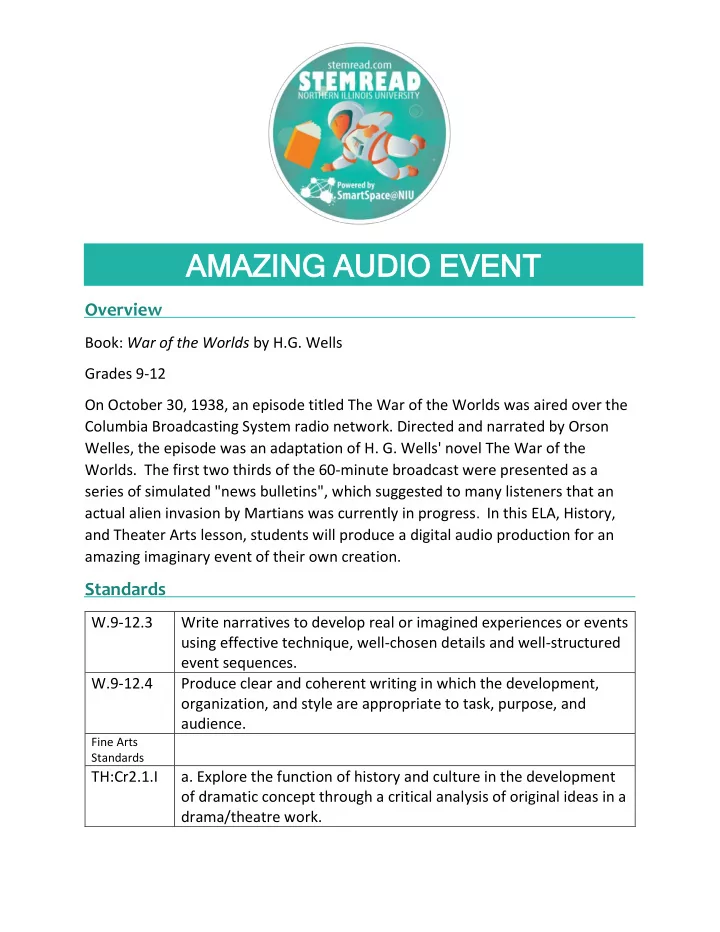

AMAZING AUDIO EVENT AMAZING AUDIO EVENT Overview Book: War of the Worlds by H.G. Wells Grades 9-12 On October 30, 1938, an episode titled The War of the Worlds was aired over the Columbia Broadcasting System radio network. Directed and narrated by Orson Welles, the episode was an adaptation of H. G. Wells' novel The War of the Worlds. The first two thirds of the 60-minute broadcast were presented as a series of simulated "news bulletins", which suggested to many listeners that an actual alien invasion by Martians was currently in progress. In this ELA, History, and Theater Arts lesson, students will produce a digital audio production for an amazing imaginary event of their own creation. Standards W.9-12.3 Write narratives to develop real or imagined experiences or events using effective technique, well-chosen details and well-structured event sequences. W.9-12.4 Produce clear and coherent writing in which the development, organization, and style are appropriate to task, purpose, and audience. Fine Arts Standards TH:Cr2.1.I a. Explore the function of history and culture in the development of dramatic concept through a critical analysis of original ideas in a drama/theatre work.
TH:Cr3.1.I a. Practice and revise a unified devised or scripted drama/theatre work using theatre conventions. b. Explore physical, vocal, and psychological choices to develop a performance that is believable, authentic, and relevant to a dram/theatre work. TH:Pr4.1.I a. Apply choices to the interpretation of a drama/theatre work. TH:Re8.1.I b. Identify and compare cultural perspectives and contexts that may influence the interpretation of a drama/theatre work. Social Science SS.H.5.9-12 Analyze the factors and historical context that influenced the perspectives of people during different historical eras. Objectives Students will research science, technology, and communication capabilities in the 1930’s. Students will draw conclusions about the culture of the 1930’s era. Students will write a script about an imaginary event. Students will rehearse and develop production values for a digital audio presentation. Students will perform the script and create the audio presentation. Materials Required Access to Internet Access to software and equipment needed for audio presentation Paper and pencil Prior Knowledge Students will need to be able to use the production equipment. Students will need to understand the term “production value” and what elements increase the quality of this concept.
Procedure 1. Have students work in groups to research the culture and technology in the 1930’s. Be sure that students are prepared to answer these questions. How did people communicate with one another? How did people get their news? What type of sciences were being explored at that time? How would people learn what was happening in other parts of the world? What impact did events of the day have on people’s ability to understand the world around them? 2. Play the original version or portions of the broadcast, available here. https://www.youtube.com/watch?v=Xs0K4ApWl4g 3. Have a discussion with the students about why they think so many people thought this might be an actual news report. 4. Have each student/group make a list of production values or script lines that made the broadcast so dramatic and realistic. 5. Have students work in groups to create a similar style presentation about an imaginary dramatic or unusual event. 6. Allow time for script writing and revision. 7. Stress the importance of rehearsal time and further revision. 8. Allow time for students to produce the audio presentation. 9. Have students share the productions with the class or other audiences. Extensions 1. Substitute an actual historical event. Students spend time first researching the history, then create the audio presentation as if the event were happening today. 2. Go “old school”. Have students prepare a live radio script about an event. Have them use items around the room or from home to make the sound effects as they did during the 30’s and 40’s. 3. Encourage students to listen to other radio programs, noting how these achieved the intended purpose. Rubric
Partially Meets Does Not Meet RUBRIC Exceeds (3) Meets (2) (1) (0) Research Student is able to Student is able to Student is able to Student is able to name 6 or more name 4-5 name 2-3 name 5 or more cultural/historical cultural/historical cultural/historical cultural/historical facts about the facts about the facts about the facts about the 1930’s. 1930’s. 1930’s. 1930’s. Discussion Student actively Student actively Student Student does not participates in participates in participates in participate in discussion and discussion and can discussion but discussion provides multiple provide a supporting does not provide strong arguments argument for a a supporting for conclusions stated conclusion argument for a stated stated conclusion Script Narrative is highly Narrative uses Narrative Narrative developed using effective technique, wanders, has few wanders, no effective some details with details and poorly details and technique, well- basically structured sequenced events sequence is not chosen details and event sequences. logical well-structured event sequences. Presentation Presentation has Presentation has Presentation has Presentation has no mistakes, uses a few mistakes, some many mistakes, many mistakes, large variety of techniques to few techniques to no added techniques to increase production increase techniques to increase value and clear production value increase production value, audio and quality of and quality of production value, has clear audio dialogue. audio and audio and quality and dialogue is poor dialogue is dialogue. extremely poor Total N/12
STEM Read and SmartSpace@NIU are part of Northern Illinois University’s STEAM Works Initiative.
Recommend
More recommend